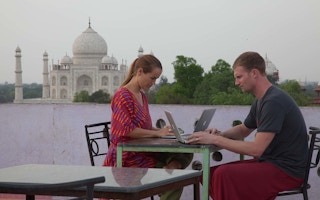The Covid-19 pandemic is what drove the British-Peruvian 33-year-old to become a so-called “digital nomad”.
“The lifestyle gives me a lot of choice and freedom,” he told the Thomson Reuters Foundation. Soto made the decision to work only for companies that offer fully remote working in order to fulfil his passion for travel, he explained.
Soto is now also part of a growing trend among digital nomads who are looking for a less frenetic pace of life.
These new “slomads” still travel around the globe taking their work with them, but are choosing to spend longer in one location - some to enjoy a richer cultural experience while others are driven by the desire to be more eco-conscious.
Remote and flexible working has boomed since coronavirus lockdowns lifted globally, backed by major companies from AirBnB to Twitter and a rising number of nations issuing digital nomad visas which allow people to stay and work for up to two years.
The typical profile of a digital nomad is shifting, as island-hopping 20-somethings are joined by online workers in their 30s and 40s travelling with partners and children, experts and researchers say.
But concerns are growing over their environmental impact.
“
If we don’t manage to align economic values with the ecological, then we’re really doomed as a species.
Samuel Delesque, founder, Traditional Dream Factory
While data is scarce on the carbon footprint of digital nomads, “slomads” are striving to fly less, stay in sustainable accommodation, and invest in, or contribute to, green projects.
However, climate campaigners are not convinced, saying the social phenomenon still depends on air travel, which produces up to 3 per cent of global greenhouse gas emissions.
“I think we feel a bit guilty, because the main issue with this lifestyle is the flying,” said Emmanuel Guisset, a former digital nomad who is now chief executive of Outsite, which offers co-living spaces for people including remote workers.
Slowing down
Pre-pandemic, the stereotype of a digital nomad was a freelancer in their 20s bouncing between sunny locales and sporting little more than shorts, flip-flops and a laptop.
Now, more people are combining work with travel later in life - often staying longer in one place to benefit from cheaper rents and better appreciating and contributing to local culture.
A poll published in May by freelancer marketplace Fiverr and travel guide publisher Lonely Planet showed one-third of nomads surveyed moving every one to three months, while 55 per cent enjoyed working in one location and moving after three months or more.
Americans make up the majority of digital nomads. A 2021 study from Upwork on the habits of hiring managers estimated that 36.2 million US citizens would work remotely by 2025, an 87 per cent increase from pre-pandemic levels.
Tourist hot-spots have been quick to embrace digital nomads, and view the growing trend of remaining longer in one location as a way to recoup losses from pandemic lockdowns.
Destinations such as Aruba, Barbados, Cape Verde, Croatia, Estonia, Indonesia, Malta and Norway have created digital nomad visas, allowing people to stay put and work for up to two years.
Accommodation rental company AirBnB saw a 90 per cent rise in long-term bookings in Portugal last year compared to 2019, which it said reflected how more people are taking advantage of the ability to work and live from anywhere.
Yet digital nomads admit there is still a lot of flying involved, especially since the easing of Covid-19 restrictions, although experts say it is difficult to identify nomads’ share of flights compared with tourism and business passengers.
Denise Auclair, corporate aviation expert at European clean transport campaign group, Transport and Environment (T&E), said there was “a golden opportunity” to continue with the reduced level of business travel seen during the pandemic, and to cut down on unnecessary flying.
But she queried whether companies are factoring the carbon footprint of employees working as digital nomads into their annual emissions reports.
Guisset of Outsite said nomads are increasingly turning to carbon offsets, whereby people seek to compensate their climate impact by funding projects that reduce emissions through activities such as planting trees.
Some environmental groups, however, have dismissed such carbon-credit schemes as “window dressing”.
“It gives people a false sense of flying green, when there are so many problems with it,” said Dewi Zloch, aviation expert at Greenpeace Netherlands.
She pointed to research done for the European Commission in 2017 which said carbon-offsetting schemes are not providing real and measurable emissions reductions.
Green living
The pandemic-driven remote work boom, meanwhile, has encouraged the creation of co-living and co-working spaces, some of which are trying to put green ideas into practice.
When Outsite first started with its California co-living property, the company planted a tree for each booking made in locations from the Andes mountains to Indonesia.
Traditional Dream Factory, a co-living space in Portugal’s vast rural Alentejo region which plans to launch in summer 2023, is trying something more ambitious.
Co-founder Samuel Delesque said the aim is to set up a community of like-minded digital nomads, engineers, artists and crypto entrepreneurs who will also regenerate the land.
The organisation has already started covering deforested areas with nitrogen-fixing crops and planted hundreds of trees.
It also plans to insulate its living quarters and create natural pools and showers to save water and become self-sufficient.
A former software engineer and digital nomad, Delesque plans to expand in countries like South Africa and the United States.
Caring for the environment is at the heart of his project, the Franco-Danish entrepreneur said.
“If we don’t manage to align economic values with (the) ecological, then we’re really doomed as a species,” he added.
This story was published with permission from Thomson Reuters Foundation, the charitable arm of Thomson Reuters, that covers humanitarian news, climate change, resilience, women’s rights, trafficking and property rights. Visit http://news.trust.org/climate.










